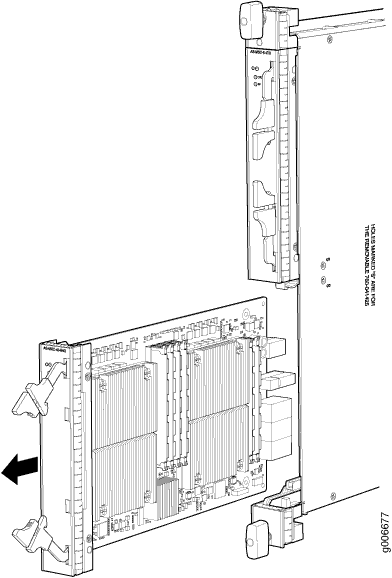Maintaining MX240 Interface Modules
Maintaining MX240 DPCs
Purpose
For optimum router performance, verify the condition of the Dense Port Concentrators (DPCs). The router can have up to three DPCs mounted horizontally in the DPC card cage at the front of the chassis.
Action
On a regular basis:
Check the LEDs on the craft interface directly above each DPC slot. The green LED labeled OK lights steadily when a DPC is functioning normally.
Check the OK/FAIL LED on the DPC. If the DPC detects a failure, the DPC sends an alarm message to the Routing Engine.
Issue the CLI
show chassis fpccommand to check the status of installed DPCs. As shown in the sample output, the valueStatein the column labeledStateindicates that the DPC is functioning normally:user@host> show chassis fpc Temp CPU Utilization (%) Memory Utilization (%) Slot State (C) Total Interrupt DRAM (MB) Heap Buffer 0 Online 41 9 0 1024 15 57 1 Online 43 5 0 1024 16 57 2 Online 43 11 0 1024 16 57For more detailed output, add the
detailoption. The following example does not specify a slot number, which is optional:user@host> show chassis fpc detail Slot 0 information: State Online Temperature 33 degrees C / 91 degrees F Total CPU DRAM 1024 MB Total RLDRAM 256 MB Total DDR DRAM 4096 MB Start time: 2007-12-06 11:33:00 PST Uptime: 4 hours, 34 minutes, 49 seconds Slot 1 information: State Online Temperature 33 degrees C / 91 degrees F Total CPU DRAM 1024 MB Total RLDRAM 256 MB Total DDR DRAM 4096 MB Start time: 2007-12-06 11:33:01 PST Uptime: 4 hours, 34 minutes, 48 seconds Slot 2 information: State Online Temperature 33 degrees C / 91 degrees F Total CPU DRAM 1024 MB Total RLDRAM 256 MB Total DDR DRAM 4096 MB Start time: 2007-12-06 11:33:05 PST Uptime: 4 hours, 34 minutes, 44 seconds
Issue the CLI
show chassis fpc pic-statuscommand. The DPC slots are numbered 1/0, 1, and 2, bottom to top:user@host> show chassis fpc pic-status Slot 0 Online DPCE 4x 10GE R PIC 0 Online 1x 10GE(LAN/WAN) PIC 1 Online 1x 10GE(LAN/WAN) PIC 2 Online 1x 10GE(LAN/WAN) PIC 3 Online 1x 10GE(LAN/WAN) Slot 1 Online DPCE 40x 1GE R PIC 0 Online 10x 1GE(LAN) PIC 1 Online 10x 1GE(LAN) PIC 2 Online 10x 1GE(LAN) PIC 3 Online 10x 1GE(LAN) Slot 2 Online DPCE 40x 1GE R PIC 0 Online 10x 1GE(LAN) PIC 1 Online 10x 1GE(LAN) PIC 2 Online 10x 1GE(LAN) PIC 3 Online 10x 1GE(LAN)
For further description of the output from the command, see the CLI Explorer.
See Also
Holding an MX240 DPC
When carrying a DPC, you can hold it either vertically or horizontally.
A DPC weighs 14.5 lb (6.6 kg). Be prepared to accept the full weight of the DPC as you lift it.
To hold a DPC vertically:
- Orient the DPC so that the faceplate faces you. To verify orientation, confirm that the text on the DPC is right-side up and the electromagnetic interference (EMI) strip is on the right-hand side.
- Place one hand around the DPC faceplate about a quarter of the way down from the top edge. To avoid deforming the EMI shielding strip, do not press hard on it.
- Place your other hand at the bottom edge of the DPC.
If the DPC is horizontal before you grasp it, place your left hand around the faceplate and your right hand along the bottom edge.
To hold a DPC horizontally:
Orient the DPC so that the faceplate faces you.
Grasp the top edge with your left hand and the bottom edge with your right hand.
You can rest the faceplate of the DPC against your body as you carry it.
As you carry the DPC, do not bump it against anything. DPC components are fragile.
Never hold or grasp the DPC anywhere except places that this document indicates. In particular, never grasp the connector edge, especially at the power connector in the corner where the connector and bottom edges meet. See Figure 1.
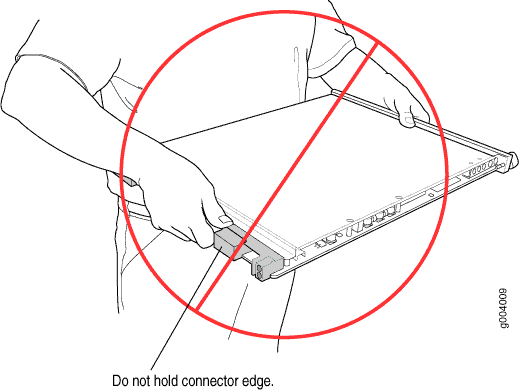
Never carry the DPC by the faceplate with only one hand.
Do not rest any edge of a DPC directly against a hard surface (see Figure 2).
Do not stack DPCs.
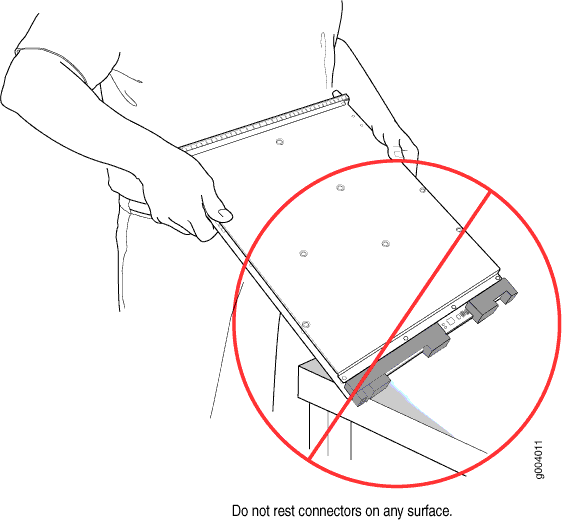
If you must rest the DPC temporarily on an edge while changing its orientation between vertical and horizontal, use your hand as a cushion between the edge and the surface.
See Also
Storing an MX240 DPC
You must store a DPC as follows:
In the router
In the container in which a spare DPC is shipped
Horizontally and sheet metal side down
When you store a DPC on a horizontal surface or in the shipping container, always place it inside an antistatic bag. Because the DPC is heavy, and because antistatic bags are fragile, inserting the DPC into the bag is easier with two people. To do this, one person holds the DPC in the horizontal position with the faceplate facing the body, and the other person slides the opening of the bag over the DPC connector edge.
If you must insert the DPC into a bag by yourself, first lay the DPC horizontally on a flat, stable surface, sheet metal side down. Orient the DPC with the faceplate facing you. Carefully insert the DPC connector edge into the opening of the bag, and pull the bag toward you to cover the DPC.
Never stack a DPC under or on top of any other component.
See Also
Replacing an MX240 DPC
Removing an MX240 DPC
A DPC weighs up to 13.1 lb (5.9 kg). Be prepared to accept its full weight.
To remove a DPC (see Figure 3):
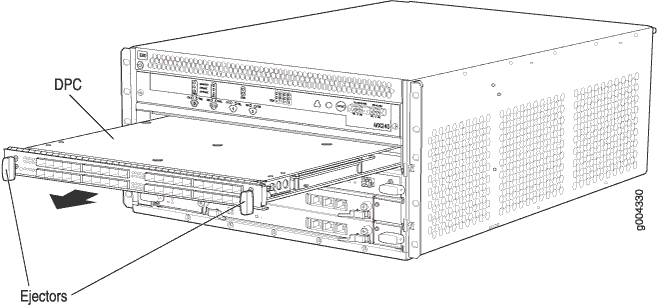
See Also
Installing an MX240 DPC
A DPC weighs up to 14.5 lb (6.6 kg). Be prepared to accept its full weight.
To install a DPC (see Figure 4):
You can also verify that the DPC is functioning correctly by
issuing the show chassis fpc and show chassis fpc pic-status commands.
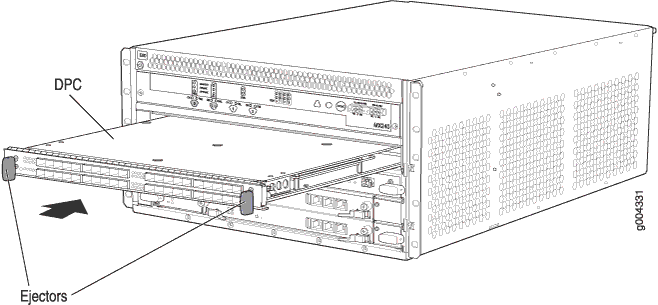
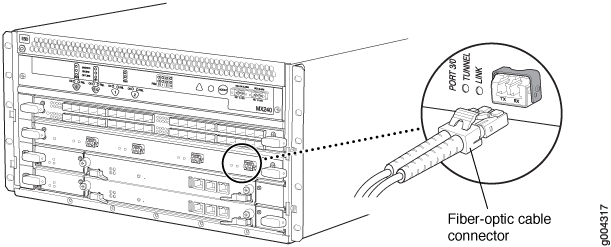
Maintaining MX240 FPCs
Purpose
The MX240 router can have one Flexible PIC Concentrator (FPC) installed horizontally in the front of the chassis. For optimum router performance, verify the condition of the FPC.
Action
On a regular basis:
Check the LEDs on the craft interface directly above the FPC. The green LED labeled OK lights steadily when an FPC is functioning normally.
Check the OK/FAIL LED on the FPC. If the FPC detects a failure, the FPC sends an alarm message to the Routing Engine.
Issue the CLI
show chassis fpccommand to check the status of the installed FPC. As shown in the sample output, the valueStatein the column labeledStateindicates that the FPC is functioning normally:user@host> show chassis fpc Temp CPU Utilization (%) Memory Utilization (%) Slot State (C) Total Interrupt DRAM (MB) Heap Buffer 0 Online 33 8 0 1024 18 30 1 Online 37 3 0 1024 12 21 2 EmptyFor more detailed output, add the
detailoption. The following example does not specify a slot number, which is optional:user@host> show chassis fpc detail Slot 0 information: State Online Temperature 33 degrees C / 91 degrees F Total CPU DRAM 1024 MB Total RLDRAM 256 MB Total DDR DRAM 4096 MB Start time: 2008-11-25 11:16:41 PST Uptime: 25 minutes, 28 seconds Slot 1 information: State Online Temperature 37 degrees C / 98 degrees F Total CPU DRAM 1024 MB Total RLDRAM 128 MB Total DDR DRAM 2048 MB Start time: 2008-11-25 11:16:43 PST Uptime: 25 minutes, 26 seconds
Issue the CLI
show chassis fpc pic-statuscommand. The following example shows an FPC installed in DPC slots 1 and 2:user@host> show chassis fpc pic-status Slot 0 Online DPC 40x 1GE R PIC 0 Online 10x 1GE(LAN) PIC 1 Online 10x 1GE(LAN) PIC 2 Online 10x 1GE(LAN) PIC 3 Online 10x 1GE(LAN) Slot 1 Online MX FPC Type 3 PIC 0 Online 1x OC-192 SONET PIC 1 Online 1x OC-192 SONETNote:An FPC takes up two DPC slots when installed on an MX Series router. The slot number corresponds to the lowest numbered DPC slot.
For further description of the output from the command, see the CLI Explorer.
See Also
Holding an MX240 FPC
Many components on the FPC are fragile. Failure to handle FPCs as specified in this document can cause irreparable damage.
An FPC configured with PICs installed can weigh as much as 18 lb (8.2 kg). Be prepared to accept the full weight of the FPC as you lift it.
To prevent damage when handling or carrying FPCs:
As you carry the FPC, do not bump it against anything. FPC components are fragile.
Do not grasp the FPC anywhere except places that this document indicates. In particular, never grasp the connector edge, especially at the power connector in the corner where the connector and bottom edges meet (see Figure 6).
Figure 6: Do Not Grasp the Connector Edge
Do not carry the FPC by the faceplate with only one hand (see Figure 7).
Figure 7: Do Not Carry an FPC with Only One Hand
Do not rest any edge of an FPC directly against a hard surface (see Figure 8). If you must rest the FPC temporarily on an edge while changing its orientation between vertical and horizontal, use your hand as a cushion between the edge and the surface.
Figure 8: Do Not Rest the FPC on an Edge
You hold an FPC horizontally when installing it into the chassis or an equipment rack. To hold an FPC vertically (see Figure 9):
- Orient the FPC so that the faceplate faces you.
- Place one hand around the FPC faceplate about a quarter of the way down from the top edge. To avoid deforming the electromagnetic interference (EMI) shielding strip, do not press hard on it.
- Place your other hand at the bottom edge of the FPC. If the FPC has heat sinks about midway between the faceplate and connector edge, place your other hand against the heat sinks.
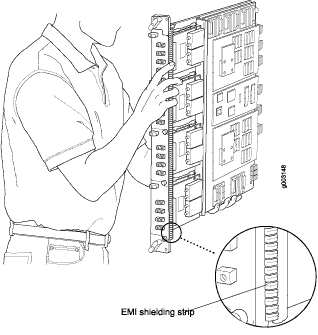
See Also
Storing an MX240 FPC
When not installed in the routers, FPCs must be either stored in the container in which a spare FPC is shipped or stored horizontally with the component-side up on a flat, stable surface. When you store an FPC on a horizontal surface or in the shipping container, always place it inside an antistatic bag. Because the FPC is heavy and because antistatic bags are fragile, inserting the FPC into the bag is easier with two people. The storage guidelines are as follows:
When two people are storing an FPC, one person holds the FPC in the horizontal position with the faceplate facing their body, the other person slides the opening of the bag over the FPC connector edge.
When one person is storing an FPC, you must insert the FPC into a bag by yourself. First lay the FPC horizontally on a flat, stable surface, component-side up. Orient the FPC with the faceplate facing you. Carefully insert the FPC connector edge into the opening of the bag, and pull the bag toward you to cover the FPC.
To prevent damage when storing FPCs:
Never lay an FPC component-side down.
Never stack an FPC under or on top of any other component (see Figure 10).

See Also
Replacing an MX240 FPC
Removing an MX240 FPC
When you remove an FPC, the router continues to function, although the PIC interfaces installed on the FPC being removed no longer function.
An FPC takes up two DPC slots on the MX240 router. One FPC can be installed horizontally in the front of the router. The FPCs are hot-insertable and hot-removable. A fully configured FPC can weigh up to 18 lb (8.2 kg). Be prepared to accept its full weight.
To remove an FPC (see Figure 11):
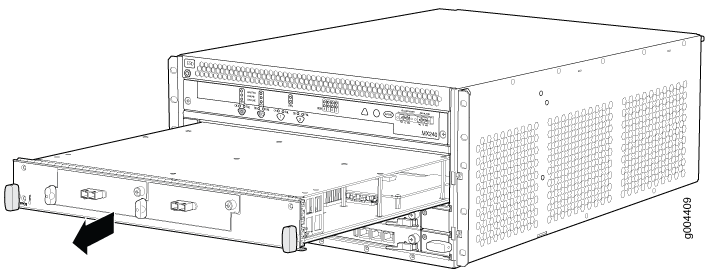
See Also
Installing an MX240 FPC
An FPC takes up two DPC slots on the MX240 router. One FPC can be installed horizontally in the front of the router. The FPCs are hot-insertable and hot-removable. A fully configured FPC can weigh up to 18 lb (8.2 kg). Be prepared to accept its full weight.
To install an FPC (see Figure 12):
You can also verify correct FPC and PIC functioning by issuing
the show chassis fpc and show chassis fpc
pic-status commands described in Maintaining MX240 FPCs and Maintaining MX240 PICs.
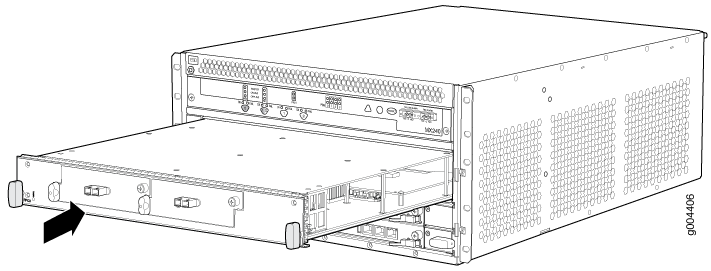
See Also
Replacing an MX240 MIC
Removing an MX240 MIC
MICs are hot-insertable and hot-removable. When you remove a MIC, the router continues to function, although the MIC interfaces being removed no longer function.
The MICs are located in the MPCs installed in the front of the router. A MIC weighs less than 2 lb (0.9 kg).


See Also
Maintaining MX240 MICs
Purpose
For optimum router performance, verify the condition of the MICs.
Action
On a regular basis:
Check the LEDs on MIC faceplates. The meaning of the LED states differs for various MICs. For more information, see the MX Series Interface Module Reference. If the MPC that houses the MIC detects a MIC failure, the MPC generates an alarm message to be sent to the Routing Engine.
Issue the CLI
show chassis fpc pic-statuscommand. The MIC slots in an MPC are numbered PIC 0/1 and PIC 2/3, left to right:user@host> show chassis fpc pic-status Slot 0 Online MPC Type 2 3D EQ PIC 0 Online 1x 10GE XFP PIC 1 Online 1x 10GE XFP Slot 1 Online MPC 3D 16x 10GE PIC 0 Online 4x 10GE(LAN) SFP+ PIC 1 Online 4x 10GE(LAN) SFP+ PIC 2 Online 4x 10GE(LAN) SFP+ PIC 3 Online 4x 10GE(LAN) SFP+ Slot 2 Online MS-DPC PIC 0 Online MS-DPC PIC PIC 1 Online MS-DPC PIC
For further description of the output from the command, see the CLI Explorer.
See Also
Installing an MX240 Dual-Wide MIC
See Also
Maintaining MX240 MPCs
Purpose
For optimum router performance, verify the condition of the Modular Port Concentrators (MPCs). The router can have up to three MPCs mounted horizontally in the card cage at the front of the chassis.
Action
On a regular basis:
Check the LEDs on the craft interface directly above each MPC slot. The green LED labeled OK lights steadily when an MPC is functioning normally.
Check the OK/FAIL LED on the MPC. If the MPC detects a failure, the MPC sends an alarm message to the Routing Engine.
Issue the CLI
show chassis fpccommand to check the status of installed MPCs. As shown in the sample output, the valueStatein the column labeledStateindicates that the MPC is functioning normally:user@host> show chassis fpc Temp CPU Utilization (%) Memory Utilization (%) Slot State (C) Total Interrupt DRAM (MB) Heap Buffer 0 Online 36 3 0 2048 14 13 1 Online 40 5 0 2048 26 13 2 Online 41 6 0 1024 7 43For more detailed output, add the
detailoption. The following example does not specify a slot number, which is optional:user@host> show chassis fpc detail Slot 0 information: State Online Temperature 36 degrees C / 96 degrees F Total CPU DRAM 2048 MB Total RLDRAM 806 MB Total DDR DRAM 2632 MB Start time: 2009-12-22 12:27:04 PST Uptime: 6 days, 3 hours, 8 minutes, 41 seconds Max Power Consumption 450 Watts Slot 1 information: State Online Temperature 40 degrees C / 104 degrees F Total CPU DRAM 2048 MB Total RLDRAM 1324 MB Total DDR DRAM 5120 MB Start time: 2009-12-22 12:27:02 PST Uptime: 6 days, 3 hours, 8 minutes, 43 seconds Max Power Consumption 440 Watts Slot 2 information: State Online Temperature 41 degrees C / 105 degrees F Total CPU DRAM 1024 MB Total RLDRAM 128 MB Total DDR DRAM 2048 MB Start time: 2009-12-22 12:26:48 PST Uptime: 6 days, 3 hours, 8 minutes, 57 seconds Max Power Consumption 265 Watts
Issue the CLI
show chassis fpc pic-statuscommand. The MPC slots are numbered 1/0, 1, and 2, bottom to top:user@host> show chassis fpc pic-status Slot 0 Online MPC Type 2 3D EQ PIC 0 Online 1x 10GE XFP PIC 1 Online 1x 10GE XFP Slot 1 Online MPC 3D 16x 10GE PIC 0 Online 4x 10GE(LAN) SFP+ PIC 1 Online 4x 10GE(LAN) SFP+ PIC 2 Online 4x 10GE(LAN) SFP+ PIC 3 Online 4x 10GE(LAN) SFP+ Slot 2 Online MS-DPC PIC 0 Online MS-DPC PIC PIC 1 Online MS-DPC PIC
For further description of the output from the command, see the CLI Explorer.
See Also
Replacing an MX240 MPC
Removing an MX240 MPC
When you remove an MPC, the router continues to function, although the MIC interfaces installed on the MPC being removed no longer function.
An MPC installs horizontally in the front of the router. The MPCs are hot-insertable and hot-removable. A fully configured MPC can weigh up to 18.35 lb (8.3 kg). Be prepared to accept its full weight.
To remove an MPC (see Figure 19):
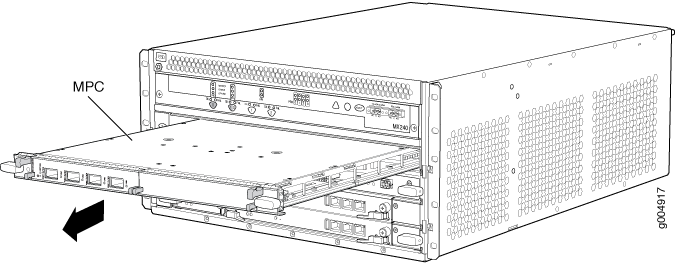
See Also
Installing an MX240 MPC
An MPC installs horizontally in the front of the router. The MPCs are hot-insertable and hot-removable. A fully configured MPC can weigh up to 18.35 lb (8.3 kg). Be prepared to accept its full weight.
To install an MPC (see Figure 20):
You can also verify correct MPC and MIC functioning by issuing
the show chassis fpc and show chassis fpc
pic-status commands described in Maintaining MX240 MPCs and Maintaining MX240 MICs.
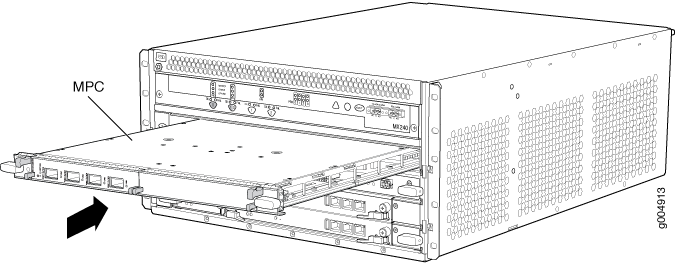
See Also
Maintaining MX240 PICs
Purpose
For optimum router performance, verify the condition of the PICs and PIC cables.
Action
On a regular basis:
Check the LEDs on PIC faceplates. The meaning of the LED states differs for various PICs. For more information, see the MX Series Interface Module Reference. If the FPC that houses the PIC detects a PIC failure, the FPC generates an alarm message to be sent to the Routing Engine.
Issue the CLI
show chassis fpc pic-statuscommand. The PIC slots in an FPC are numbered from 0 through 1, left to right:user@host> show chassis fpc pic-status Slot 0 Online DPC 40x 1GE R PIC 0 Online 10x 1GE(LAN) PIC 1 Online 10x 1GE(LAN) PIC 2 Online 10x 1GE(LAN) PIC 3 Online 10x 1GE(LAN) Slot 1 Online MX FPC Type 3 PIC 0 Online 1x OC-192 SONET PIC 1 Online 1x OC-192 SONETFor further description of the output from the command, see the CLI Explorer.
See Also
Replacing an MX240 PIC
Removing an MX240 PIC
PICs are hot-insertable and hot-removable. When you remove a PIC, the router continues to function, although the PIC interfaces being removed no longer function.
The PICs are located in the FPCs installed in the front of the router. A PIC weighs less than 2 lb (0.9 kg).
To remove a PIC (see Figure 21):
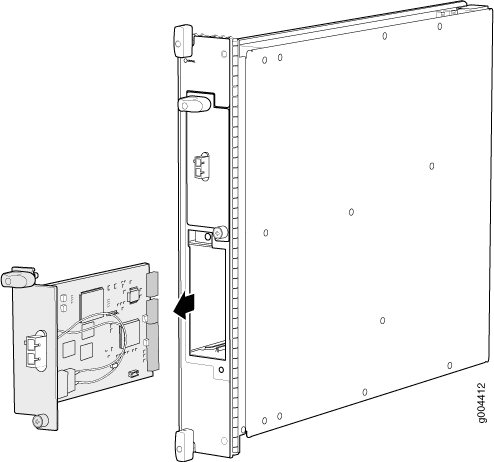
See Also
Maintaining Cables that Connect to MX240 DPCs, MPCs, MICs, or PICs
Purpose
For optimum router performance, verify the condition of the cables that connect to the DPCs, MPCs, MICs, or PICs.
Action
On a regular basis:
Keep the cable connections clean and free of dust and other particles, which can cause drops in the received power level. Always inspect cables and clean them if necessary before connecting an interface.
Label both ends of the cables to identify them.
The following guidelines apply specifically to fiber-optic cables:
When you unplug a fiber-optic cable, always place a rubber safety plug over the transceiver on the faceplate and on the end of the cable.
Anchor fiber-optic cables to avoid stress on the connectors. Be sure to secure fiber-optic cables so that they do not support their own weight as they hang to the floor. Never let fiber-optic cable hang free from the connector.
Avoid bending fiber-optic cable beyond its bend radius. An arc smaller than a few inches can damage the cable and cause problems that are difficult to diagnose.
Frequent plugging and unplugging of fiber-optic cable into and out of optical instruments can cause damage to the instruments that is expensive to repair. Instead, attach a short fiber extension to the optical equipment. Any wear and tear due to frequent plugging and unplugging is then absorbed by the short fiber extension, which is easy and inexpensive to replace.
Keep fiber-optic cable connections clean. Small microdeposits of oil and dust in the canal of the transceiver or cable connector could cause loss of light, reducing signal power and possibly causing intermittent problems with the optical connection.
To clean the transceivers, use an appropriate fiber-cleaning device, such as RIFOCS Fiber Optic Adaptor Cleaning Wands (part number 946). Follow the directions for the cleaning kit you use.
After you clean an optical transceiver, make sure that the connector tip of the fiber-optic cable is clean. Use only an approved alcohol-free fiber-optic cable cleaning kit, such as the Opptex Cletop-S Fiber Cleaner. Follow the directions for the cleaning kit you use.
See Also
Replacing a Cable on an MX240 DPC, MPC, MIC, or PIC
- Removing a Cable on an MX240 DPC, MPC, MIC, or PIC
- Installing a Cable on an MX240 DPC, MPC, MIC, or PIC
Removing a Cable on an MX240 DPC, MPC, MIC, or PIC
Removing and installing cables on a DPC, MPC, MIC, or PIC does not affect router function, except that the component does not receive or transmit data while its cable is disconnected.
To remove a cable:
See Also
Installing a Cable on an MX240 DPC, MPC, MIC, or PIC
To install a cable on a DPC, MPC, MIC, or PIC:
See Also
Replacing an SFP or XFP Transceiver from an MX240 DPC, MPC, MIC, or PIC
Small form-factor pluggable transceivers (SFPs) and XFPs are optical transceivers that are installed in a DPC, MPC, MIC, or PIC. SFPs and XFPs are hot-insertable and hot-removable.
- Removing an SFP or XFP Transceiver from an MX240 DPC, MPC, MIC, or PIC
- Installing an SFP or XFP Transceiver into an MX240 DPC, MPC, MIC, or PIC
Removing an SFP or XFP Transceiver from an MX240 DPC, MPC, MIC, or PIC
Removing an SFP or XFP does not interrupt DPC, MPC, MIC, or PIC functioning, but the removed SFP or XFP no longer receives or transmits data.
To remove an SFP or XFP transceiver (see Figure 23):
After removing a transceiver from the chassis, wait at least 30 seconds before reinserting it or inserting a transceiver into a different slot.
See Also
Installing an SFP or XFP Transceiver into an MX240 DPC, MPC, MIC, or PIC
To install an SFP or XFP:
See Also
Replacing an MX240 AS MLC
Removing an MX240 AS MLC
When you remove an Application Services Modular Line Card (AS MLC), the router continues to function, although the modular cards (AS MXC and AS MSC) installed on the AS MLC being removed no longer function.
Up to five AS MLCs can be installed horizontally in the front of the MX240 router. The AS MLCs are hot-insertable and hot-removable. An empty AS MLC weighs 10.5 lb (4.76 kg). A fully configured AS MLC can weigh up to 15.27 lb (6.93 kg). Be prepared to accept its full weight.
To remove an AS MLC (see Figure 24):
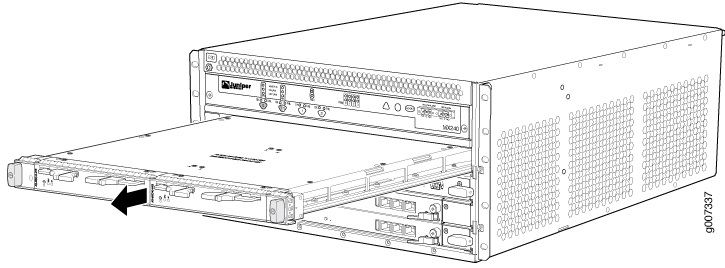
See Also
Installing an MX240 AS MLC
You can install up to five Application Services Modular Line Cards (AS MLCs) horizontally in the front of the MX240 router. The AS MLCs are hot-insertable and hot-removable. An empty AS MLC weighs 10.5 lb (4.76 kg). A fully configured AS MLC can weigh up to 15.27 lb (6.93 kg). Be prepared to accept its full weight.
To install an AS MLC (see Figure 25):
You can also verify correct AS MLC and AS MSC or AS MXC functioning
by issuing the show chassis fpc and show chassis fpc
pic-status.

See Also
Replacing an MX240 AS MSC
Removing an MX240 AS MSC
AS MSCs are hot-insertable and hot-removable. When you remove an AS MSC, the router continues to function.
The AS MSCs are located in the AS MLCs installed in the front of the router. An AS MSC weighs 1.4 lb (0.6 kg).
To remove an AS MSC (see Figure 26):

See Also
Installing an MX240 AS MSC
See Also
Replacing an MX240 AS MXC
Removing an MX240 AS MXC
AS MXCs are hot-insertable and hot-removable. When you remove an AS MXC, the router continues to function.
The AS MXCs are located in the AS MLCs installed in the front of the router. An AS MXC weighs 1.4 lb (0.6 kg).
To remove an AS MXC (see Figure 28):
